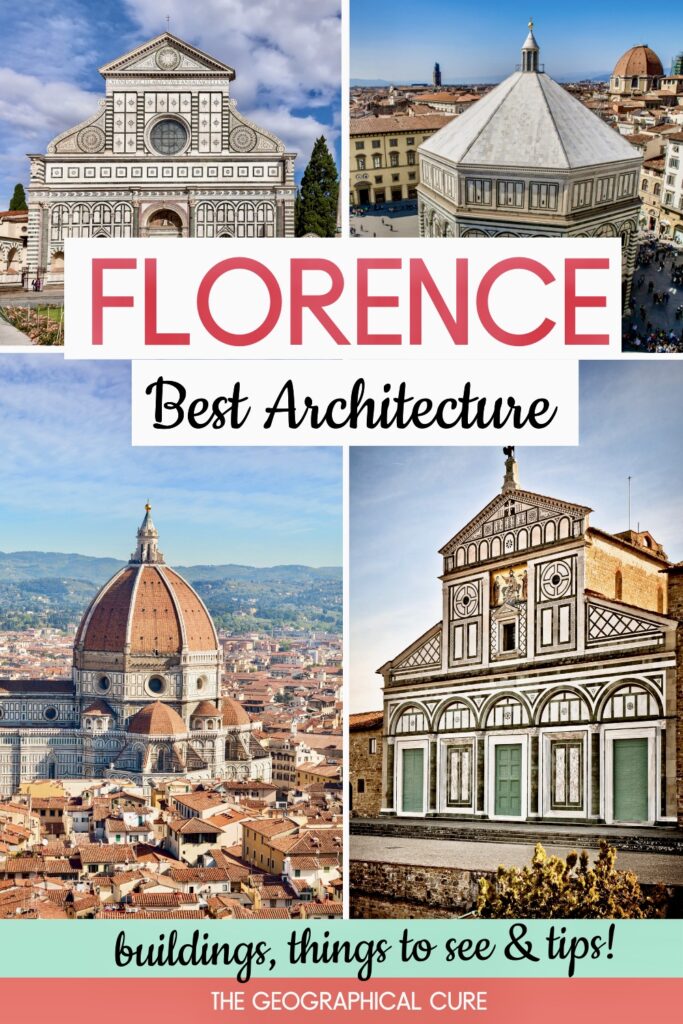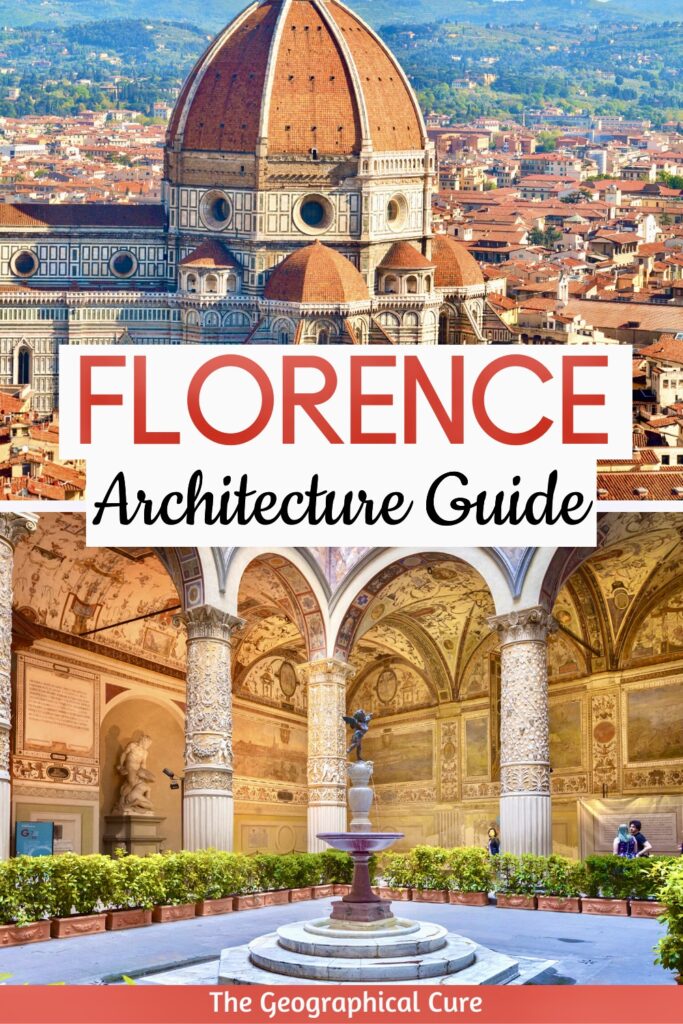Florence is a city overflowing with remarkable architecture. Though it’s known as the “Cradle of the Renaissance,” there’s plenty of Romanesque and Gothic architecture as well.
In this blog post, I take you on a tour of the city’s architectural highlights and give you my personal ranking of them.
From the iconic grandeur of the Duomo to the dynamism of Michelangelo’s New Sacristy, I’ll walk you through each building, explaining why they are special.
In ranking these structures, I’ve taken into consideration the element of innovation, the influence on architectural history, and cultural significance.
>>> Click here to book an art and architecture tour
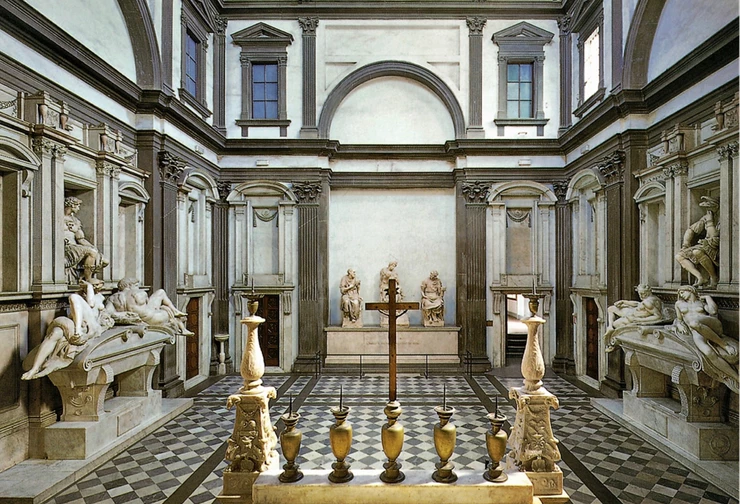
1. Michelangelo’s New Sacristy, Medici Chapels
I think the New Sacristy in the Medici Chapels, designed by the renowned Michelangelo is the city’s most exquisite architectural space. It’s reminiscent in some ways of Filippo Brunelleschi’s style with its elegant gray and white hues.
Michelangelo’s architectural vision for the space was both holistic and dynamic, effectively bringing it to life.
His approach to using architectural elements was unconventional, creating a palpable sense of tension and drama. This unique style gives the impression that the structure itself is almost in motion, lending a theatrical and vivid quality to the space.
Michelangelo used marble extensively. This choice is interesting, as marble is more typically linked with sculpture than architecture.
The sacristy has eight doors. But only one is functional, leading to the Basilica of San Lorenzo. The rest are included for their aesthetic value, maintaining the all-important symmetry of the design.
Above these doors are niches, which traditionally house statues. However, Michelangelo intentionally left them empty, utilizing them purely as decorative elements on the wall.
The broken pediments on the niches are a pioneering feature in architectural history, marking their first known use.
On the second level, rectangular windows are interspersed with symmetrical lunettes. Above that, tapering trapezoidal windows, crowned with massive stone pediments, are positioned on each side of the dome.
It’s one of the early instances of using trapezoidal shapes in architecture. Michelangelo may have become bored with circles and squares.
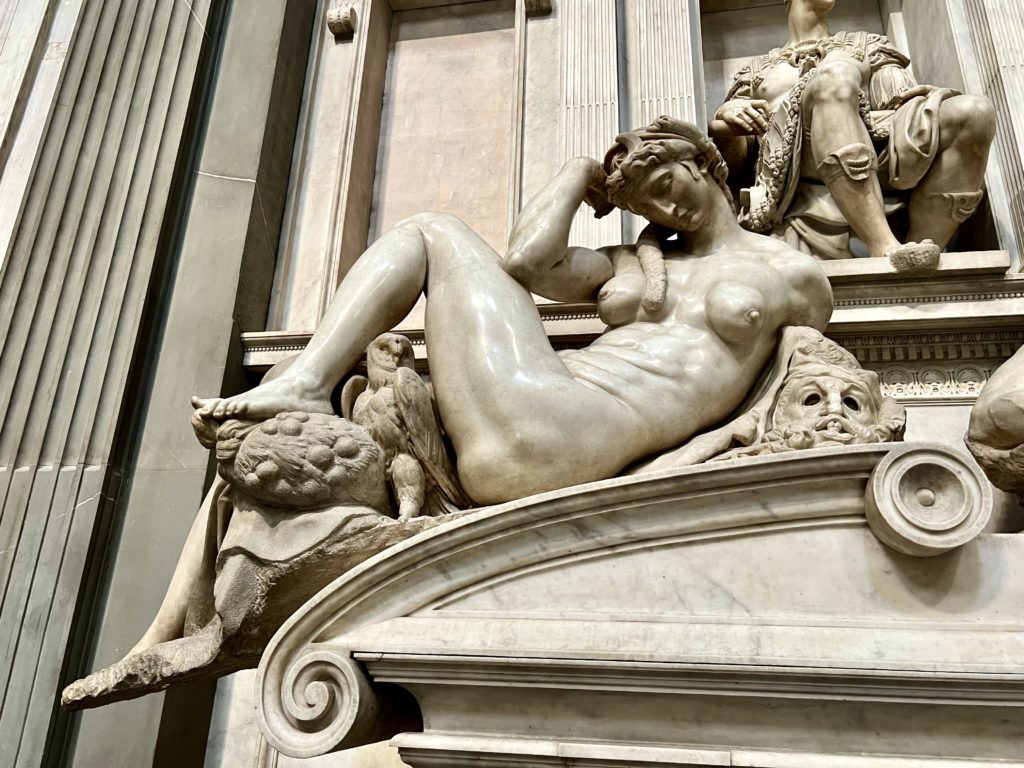
The hemispherical and coffered dome was inspired by the Pantheon in Rome. It’s covered with terra cotta shingles. Each coffer is like a mini dome.
One of the most remarkable aspects of the sacristy is the way Michelangelo integrated his sculptures into the architectural framework.
The tomb sculptures, notably those of Lorenzo de’ Medic and Giuliano de’ Medici are more than mere decorations. They are fundamental to the design’s overall cohesion.
These tombs are adorned with Michelangelo’s allegorical sculptures. Among them, Night is considered one of his most beautiful pieces.
>>> Click here to book a skip the line ticket for the Medici Chapels
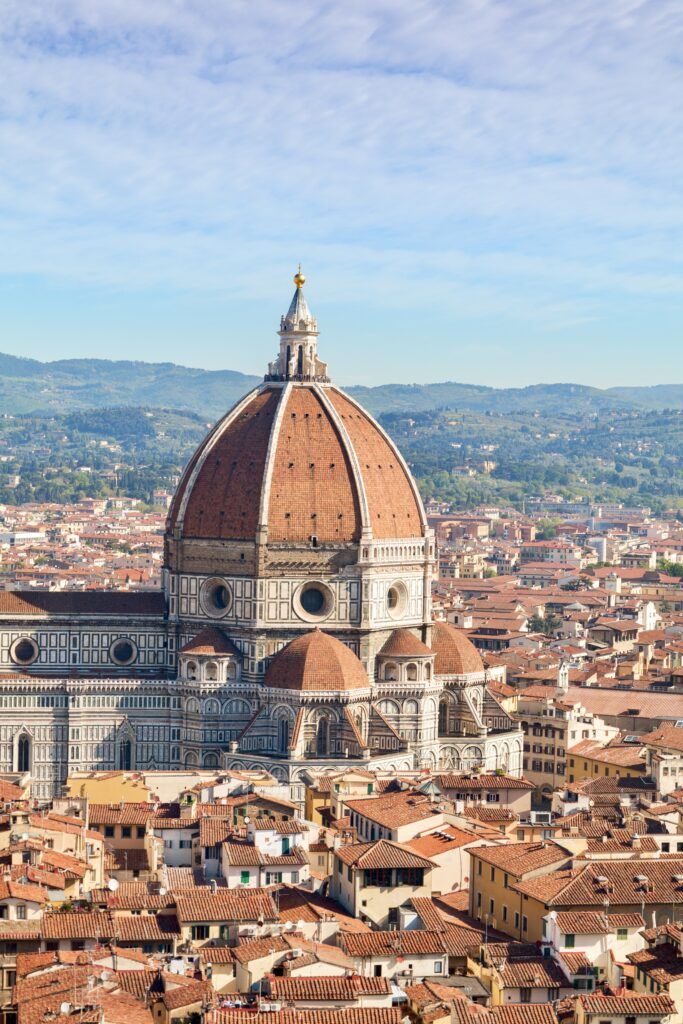
2. Florence Cathedral
The Duomo, officially known as the Cathedral of Santa Maria del Fiore, is not only the third largest Christian church in the world but also a masterpiece of Italian architecture.
Its sheer size and intricate decorations make it a marvel of the proto-Renaissance era.
Its facade is jaw dropping. It’s an eye-catching display “frosted” with green, white, and pink marble.
The immense octagonal dome, designed by the ingenious Filippo Brunelleschi, is particularly breathtaking and has become a defining symbol of Florence.
Inside, the cathedral presents a stark contrast to its lavish exterior. The interior’s austerity is a deliberate choice by chief architect Francesco Talenti. He aimed to draw visitors’ attention to the architectural form itself rather than ornate decorations.
Brunelleschi’s dome is a testament to Renaissance ingenuity and engineering prowess. For those who can manage it, climbing up to the dome is highly recommended.
The journey involves 463 steps. But it’s a path filled with wonders, including a close-up view of Giorgio Vasari’s frescoes.
Once at the top, you’re rewarded with a breathtaking panoramic view of Florence.
>>> Click here to pre-book a timed entry ticket for the dome climb
3. Basilica of Santo Spirito
Santo Spirito’s exterior is rather weird. It has an almost southwestern look. It was never completed.
The interior, though, is pure Filippo Brunelleschi — beautiful gray and white architecture, repeating Corinthian columns holding up rounded arches, and perfect proportion.
Consistent with Brunelleschi’s architectural principles, the design emphasizes simplicity and harmony. He aimed for a balanced and unified interior space, avoiding overly complex or ornate designs.
The church follows a Latin cross plan with a nave, two aisles, and transepts. One of Brunelleschi’s innovations was the use of a series of identical side chapels along the aisles, which created a rhythmic and harmonious space.
In essence, the architect created a temple that captures the classical Greco-Roman spirit. The only thing that mars it is the rather ugly tabernacle added later
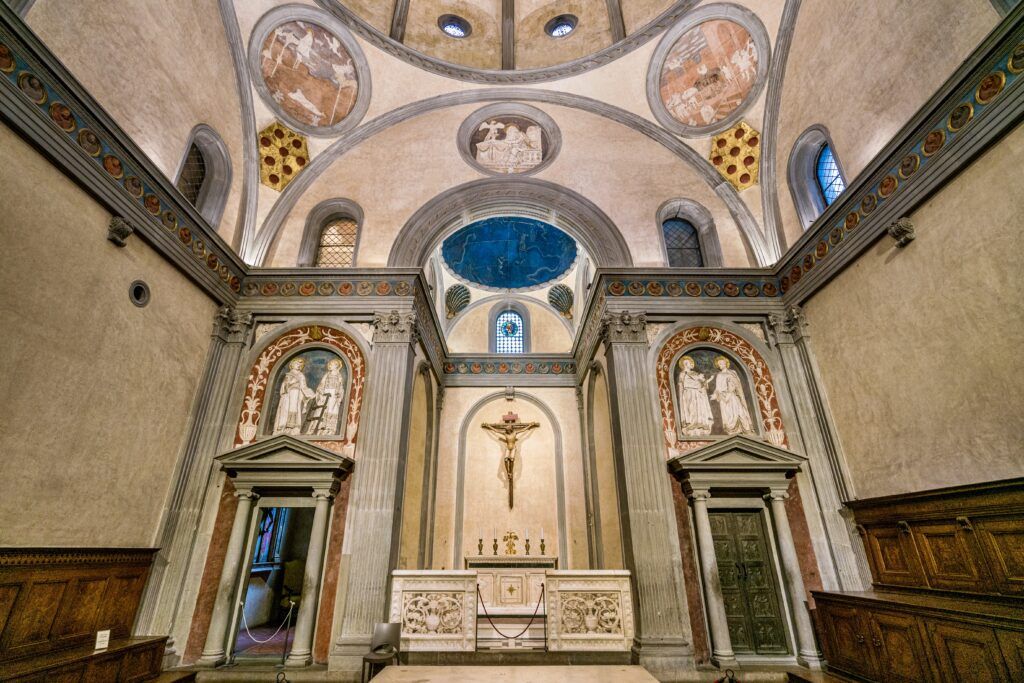
4. Old Sacristy in the Basilica of San Lorenzo
Brunelleschi was also the mastermind behind the design of the Old Sacristy in the Basilica of San Lorenzo.
This architectural masterpiece marked a pivotal moment in the evolution of Renaissance architecture.
Commissioned by the influential Medici family, the Old Sacristy’s construction started around 1421.
This project was one of Brunelleschi’s earliest and most significant works, showcasing his innovative approach to architecture that played a key role in shaping the Renaissance style.
The sacristy is renowned for its pioneering use of proportion, geometry, and perspective. This marked a revolutionary step in architecture, as Brunelleschi creatively reinterpreted classical principles for the first time.
The sacristy features a cubic layout, crowned by a distinctive umbrella dome. The dome’s pendentives are adorned with medallions representing the Evangelists.
Brunelleschi’s design also includes fluted pilasters, Corinthian columns, and smooth circular arches, forming a rhythmic architectural pattern. Interestingly, these pilasters are purely decorative, not structural – a novel approach Brunelleschi introduced.
The overall decoration is minimal, reflecting Brunelleschi’s preference for functionality and geometric simplicity. This gives the Old Sacristy a surprisingly modern appearance.
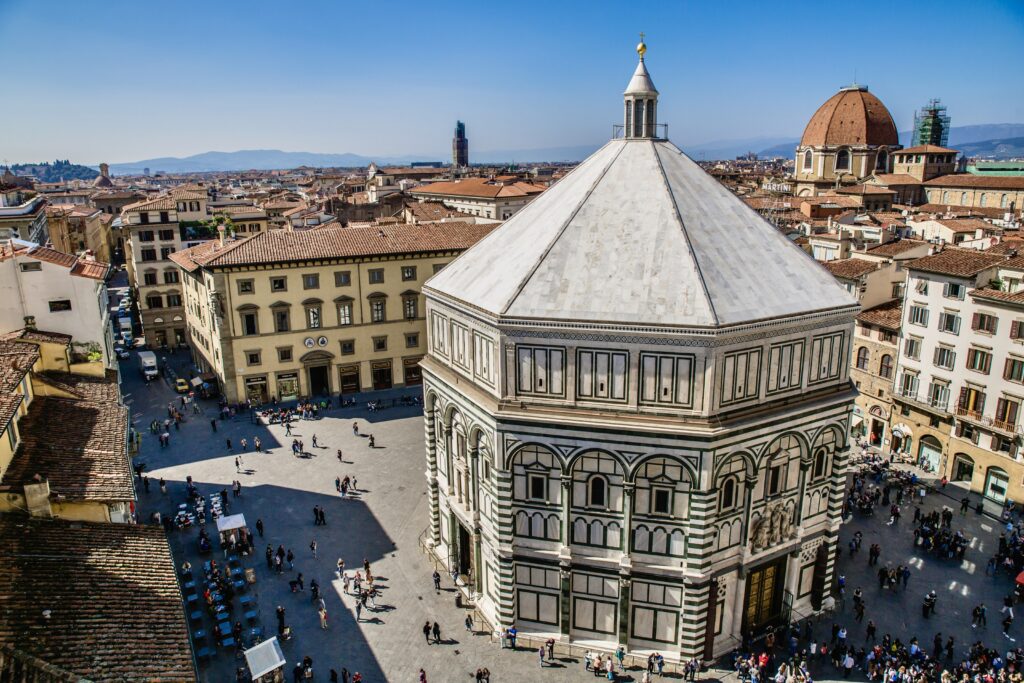
5. Baptistery
The Baptistery sits directly in front of Florence Cathedral. But it’s an independent church and holds masses in the morning.
Consecrated in 1059, it’s the second oldest building in Florence. It’s known for its three sets of bronze doors (now in the Duomo Museum) and spectacular mosaic ceiling.
It’s octagonal in plan, like most early Christian baptisteries. Each side is broken down in three bays — rectangles, arches, and more rectangles. In each corner, the pilasters have a zebra-like stone design.
Inside, there’s a marble inlaid floor, which gives it the effect of carpeting. The hall is lined with ancient Roman columns of gray granite.
The apse has a reliquary altar, which used to hold the index finger of St. John the Baptist. Above that, is a golden Byzantine-style mosaic depicting The Last Judgment.
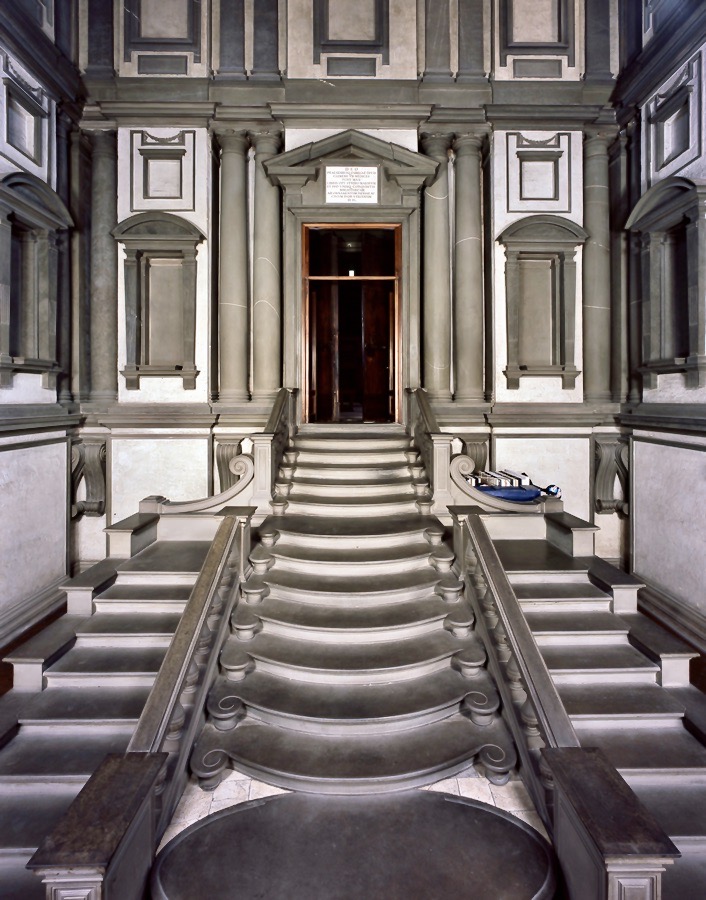
6. Laurentian Library
This Laurentian Library is part of the Church of San Lorenzo, the Medici parish church. The architect is none other than Michelangelo.
Aside from painting and sculpture, Michelangelo was a great architect. He had a distinctive vision.
You walk into the reception area and see this astonishing freestanding staircase. It’s almost as if the room were designed for the staircase, not people.
The vestibule is an example of early Mannerist architecture, breaking all the conventional rules. The walls are decorated with architectural elements — inset columns, corbels, and blind windows.
None of them serve a function. It was all aesthetic.
The staircase leads up to a handsome space, the Reading Room. It was built on top of another building, so it had to be light.
There are no columns, too heavy. Michelangelo designed everything — the ceiling, the windows, the. white and red terra cotta, floor, the reading desks, etc.
You’ll find rare manuscripts and books collected by Cosimo the Elder de’ Medici and Lorenzo the Magnificent.
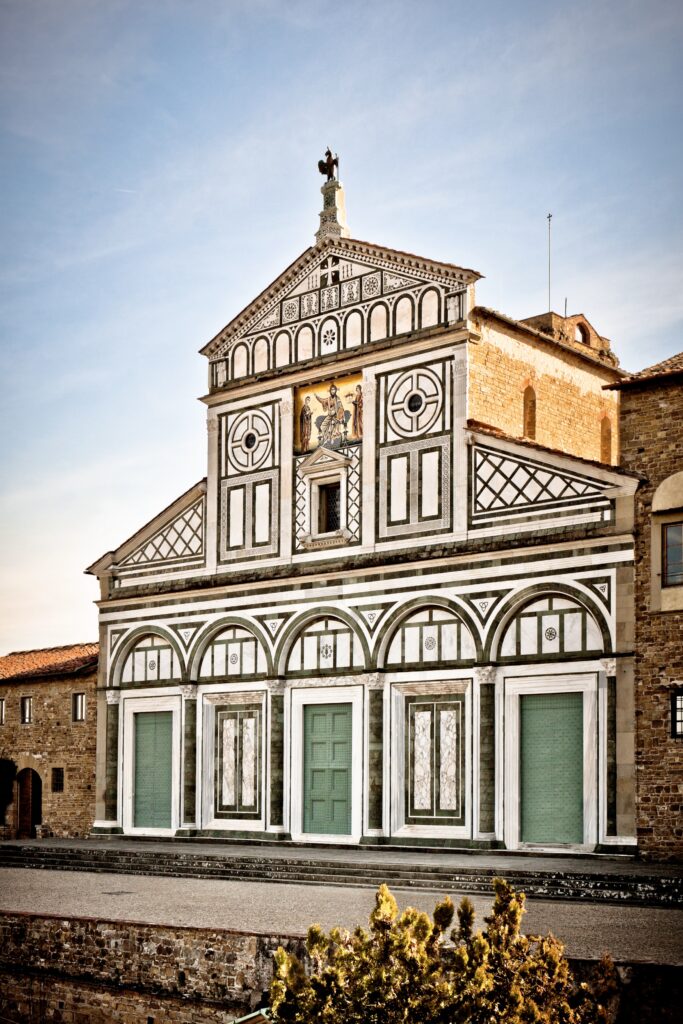
7. San Miniato al Monte
San Miniato is the oldest building in the entire city, consecrated in 1018. It’s over 1,000 years old! It’s one of the best viewpoints in Florence and worth the climb.
The facade inspired and influenced Santa Maria Novella. There are five arches with portals, inlaid with green and white marble.
On top, on the quasi Greek temple, are Byzantine style mosaics of Mary, Jesus, and St. Minias.
Inside, the church seems eclectic. It’s not in the regular Greek or Latin cross shape. It’s a rectangular shape.
Every inch is covered with marble, gold leaf, and mosaics. There are some beautiful 13th and 14th century frescos and a painting by Taddeo Gaddi over the altar.
The floors are original. You can see astronomical designs. It’s all topped with a painted wooden trussed ceiling.
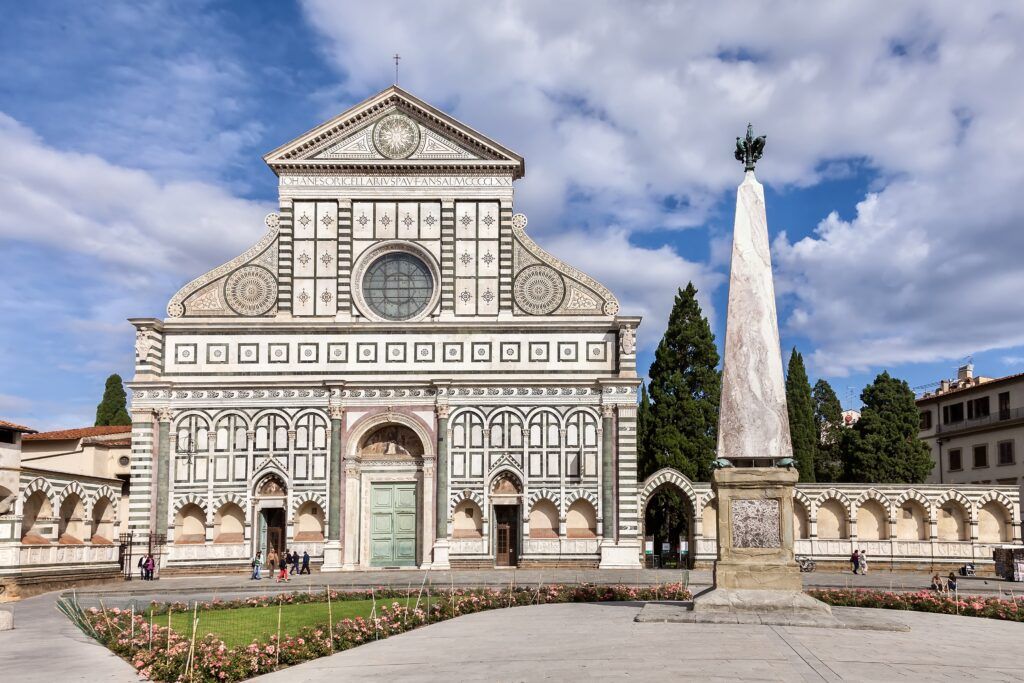
8. Santa Maria Novella
Santa Maria Novella was designed by the great Renaissance architect and theoretician Leon Battista Alberti around 1455. The striking polychrome and white marble facade is the star.
The church itself is medieval and built using pietra forte stone. But the facade is pure Renaissance, in a perfect 1:1 proportion.
It’s a gem. Pilasters connect the Gothic arches at the bottom to the rounded Renaissance arches above. Above that is a horizontal band with green squares.
The top appears like a Greek temple, much like San Miniato. The rounded S-shaped “shoulders” were revolutionary at the time. At the tip to is a triangular pediment with a large sun in the center.
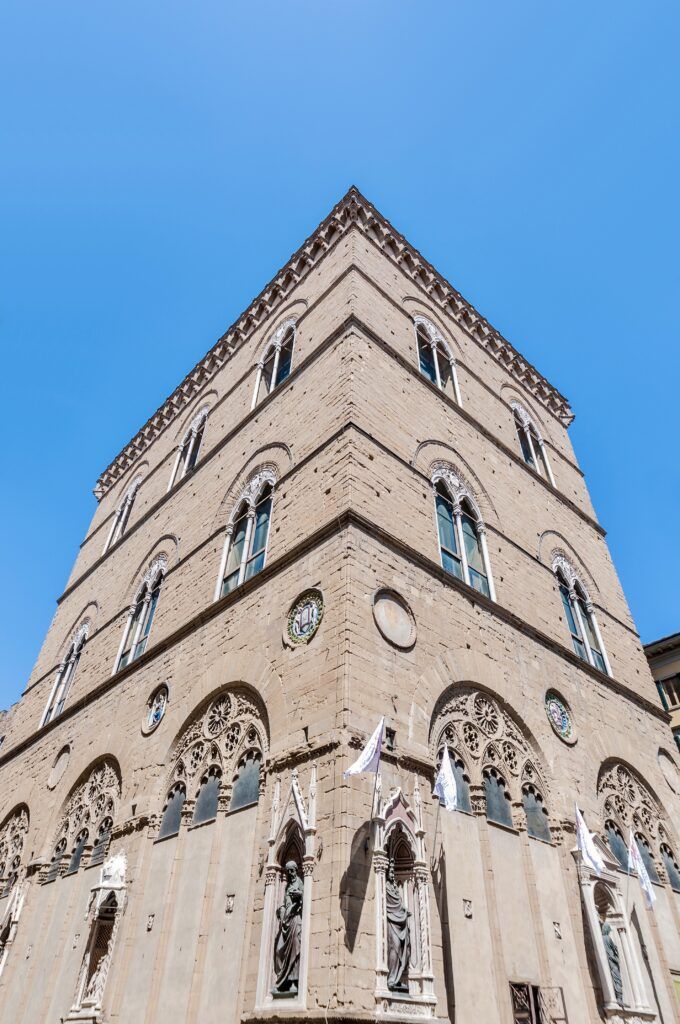
9. Orsanmichaele
This building is a robust, rectangular plan covering three stories. At the time, it was a monumental building.
Today, it looks like a gaunt medieval church incongruously set in the hurly burly of Via dei Calzaiuoli.
Its exterior is typical of Florentine Gothic architecture. It’s characterized by strong, vertical lines and a compact form, which was necessary due to its original function as a grain market.
It’s made of the usual brown sandstone. The upper levels have the Gothic bifurcate windows with tracery.
The building was formerly a grain market changed, later, into a church. So it doesn’t look much like a church.
Inside, there are two aisles. There’s a gorgeous 14th century Gothic tabernacle by sculptor and architect Andrea Orcagna. The tabernacle houses a venerated image of the Virgin Mary.
Upstairs, you’ll find some of the original sculptures that were formerly on the facade.
Tips: Orsanmichele is open very limited hours: Saturday from 10:00 am to 12:30 pm and Monday from 10:00 am to 5:00 pm.
>>> Click here to pre-book a ticket
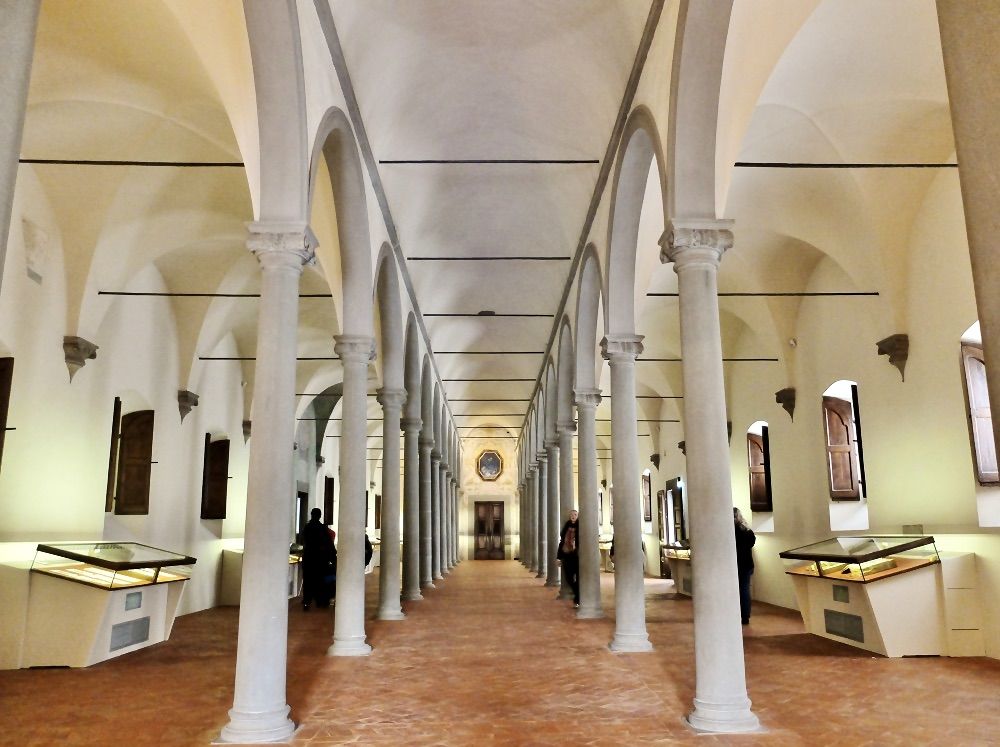
10. Library of San Marco Monastery
San Marco Monastery is a large building complex in Florence. It doesn’t always get the love it deserves. It has Florence’s largest collection of sacred art, including gorgeous paintings by Fra Angelico.
But, in terms of architecture, the most beautiful part is the Library. It was designed as part of a renovation of the complex by Michelozzo in 1443-46.
The library was one of the first public libraries in Europe and played a significant role in the intellectual and cultural life of Renaissance Florence.
It’s a three aisle rectangular space that looks a bit like a church. The central nave is narrower than the other two, divided by Ionic columns.
It’s simple, elegant, and well lit. There was formerly reading tables in the side aisles. Rare books were attached to them by chains.
While at San Marco, you can also see the Michelozzo-designed cloister and 44 monks’ cells with frescos by Fra Angelico.
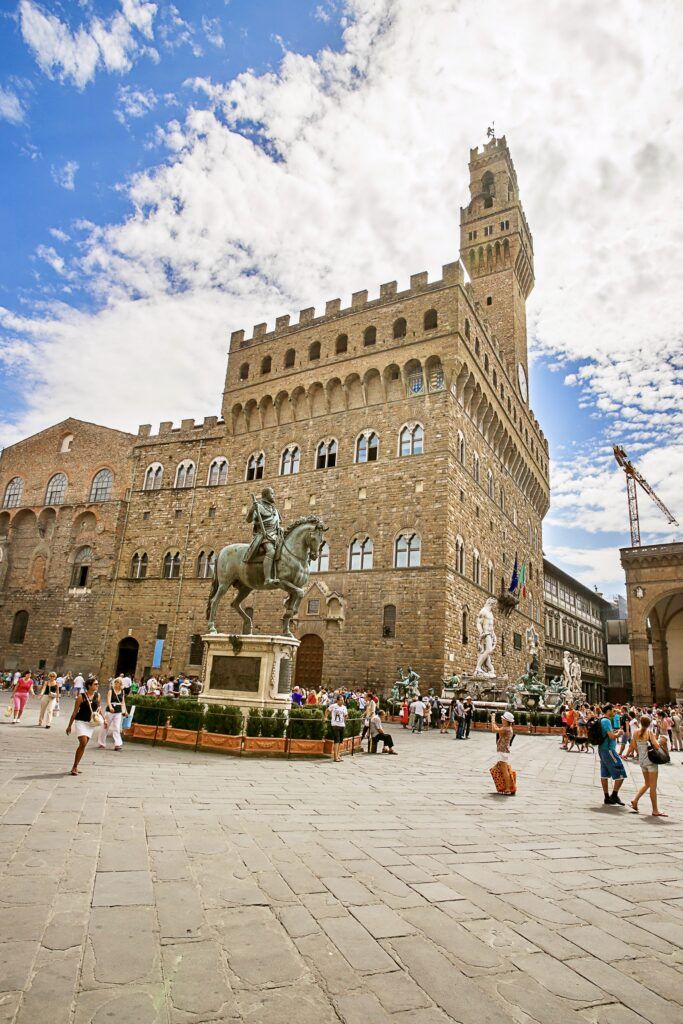
11. Palazzo Vecchio
The Palazzo Vecchio in Florence is an intriguing mix.
On the outside, it’s a formidable medieval fortress, complete with renellated battlements along the top of the building. The palace was designed to convey power and authority.
But step inside, and it transforms into a lavish Renaissance palace, overflowing with artistic masterpieces.
Built in 1298, this palace served as the government headquarters of Florence. The architect was Arnolfo di Cambio, known for his work on the Florence Cathedral and the Basilica of Santa Croce.
The interior welcomes you with a magnificent courtyard, designed in 1453 by Michelozzo.
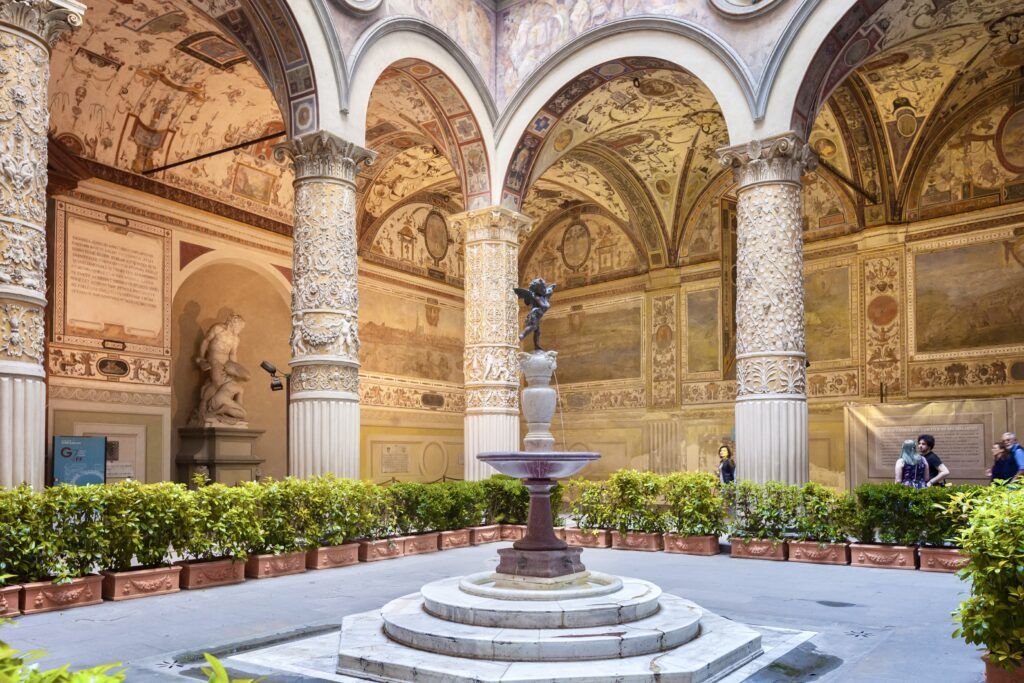
This area dazzles with its detailed columns, ceilings adorned with grotesque style frescoes, and elegant sculptures.
Don’t miss the Hall of 500, the largest room of its kind in any Italian palace. You can also tour the private Medici apartments, richly decorated with frescoes and sculptures.
And if you’re up for it, climb the 418 steps to the top of the Tower of Arnolfo for panoramic views of Florence.
Click here to book a skip the line ticket with a time slot reservation.
You can also book a guided secret passages tour with lunch. This guided 2 hour tour covers the palace and the Piazza della Signoria.
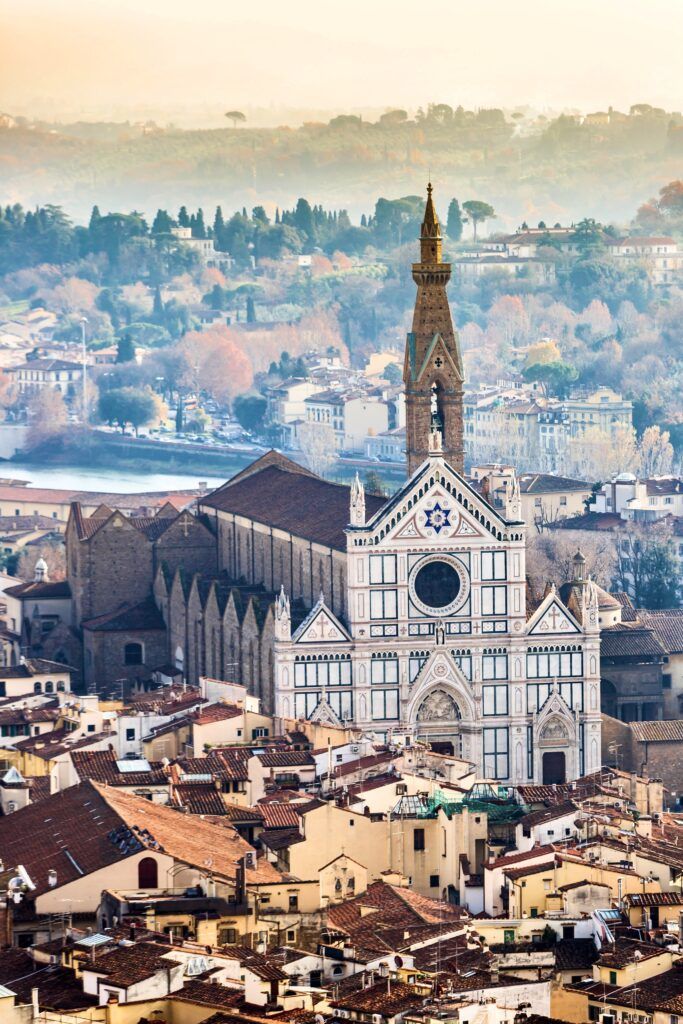
12. Basilica of Santa Croce
The Basilica of Santa Croce is an outstanding example of Italian Gothic architecture and one of Florence’s most important buildings.
It was constructed starting in the late 13th century and is famed for its art, funerary monuments, and as the burial place of illustrious Italians.
The church’s construction began around 1294, designed by architect Arnolfo di Cambio.
The facade was completed in the 19th century by Niccolò Matas. It features a mock Neo-Gothic design. (Negative points for my ranking purposes).
It contrasts with the rest of the building, but complements its overall style. The facade is adorned with polychrome marble panels in various shades of green and pink bordered by white.
The interior follows the typical basilica plan with a nave and two aisles separated by pointed arches. In contrast to the buildings in Florence designed by Michelangelo and Brunelleschi, the decoration is over-the-top with richly cluttered chapels.
The church houses an impressive array of art, including frescoes by Giotto in the Bardi and Peruzzi Chapels. Other notable artworks include pieces by Donatello, Brunelleschi, and Cimabue.
The famous Pazzi Chapel is simpler in style, probably because it was designed by Brunelleschi in 1429. It’s a masterpiece of early Renaissance architecture, known for its geometric harmony and clarity.
To the modern eye, the chapel appears severe. It’s quite a bit similar in style to Brunelleschi’s Old Sacristy.
Blue, gray, and white predominate. Instead of frescos, there are 12 blue and white glazed terracotta tiles by Luca and Andrea della Robbia.
Fun Fact: Some historians think the Pazzi Chapel is the world of Michelozzo.
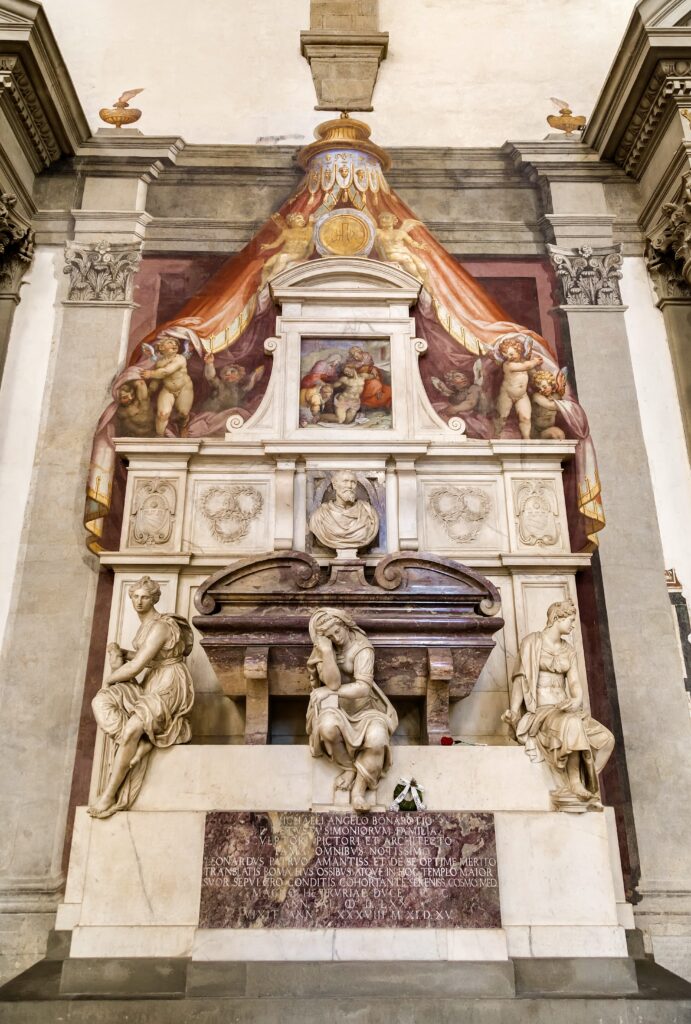
Santa Croce is often referred to as the “Pantheon of Florence” or the “Temple of Italian Glories” because it houses numerous tombs of famous individuals like Michelangelo, Galileo, Machiavelli, and Rossini.
>>> Click here to book a one hour tour
I hope you’ve enjoyed my guide to the best buildings and architecture in Florence. You may find these other Florence travel guides useful:
- 1 Day In Florence Itinerary
- 2 Days in Florence Itinerary
- 3 Days In Florence Itinerary
- Hidden Gems in Florence
- Best Museums in Florence
- Florence Art Bucket List
- Best Day Trips From Florence
- Free Things To Do In Florence
- Guide to the Medici Palaces
- Who Were the Medici?
Pin it for later.

